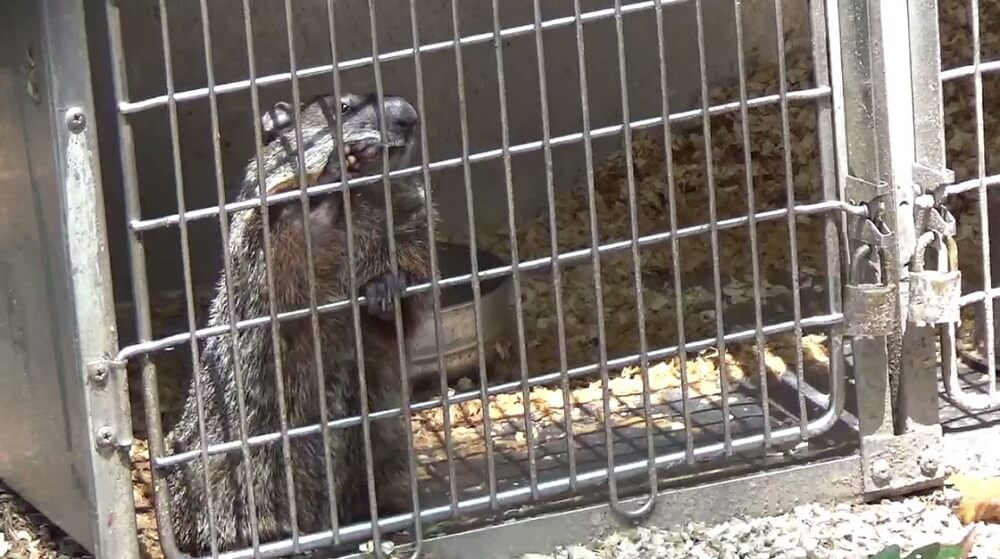Groundhog Day: Celebrate With Kind, Creative Activities

This Groundhog Day, Say No to Cruel Holiday Displays
Groundhogs are naturally shy and sensitive prey animals who become stressed when handled by humans—especially in noisy, crowded settings. A clear example of this happened in 2015, when a groundhog named Jimmy bit the mayor’s ear during the 67th annual Sun Prairie Groundhog Day celebration in Wisconsin.
Every year in Pennsylvania, Punxsutawney Phil is used as the star of a Groundhog Day event. Sadly, Phil is kept on public display at a local library year-round, where he’s denied the chance to hibernate and follow his natural rhythms. Events like these not only pose risks to the animals and their handlers but can also cause serious stress-related health problems for the groundhogs, even if they don’t show obvious injuries.
Instead of continuing this outdated and harmful tradition, you can inspire your students to show compassion for animals by exploring fascinating facts about groundhogs with TeachKind’s “All About Groundhogs” Reading Comprehension Worksheet. Students will enjoy discovering why these unique animals deserve to live freely, rather than being used as living props for entertainment.
This short, well-written activity served several goals: tracking for answers, writing answers in complete sentences with part of the question included, taking the perspective of groundhogs who prefer solitude and quiet instead of being showcased at loud public gatherings, and that groundhogs are not scientists who can predict the weather!
Jan M.
Download TeachKind’s “All About Groundhogs” Reading Comprehension Worksheet
Before Reading
Start by explaining the truth behind Groundhog Day: Many groundhogs are taken from their safe, natural homes and kept in roadside zoos or museum displays where they can’t roam, forage for food, or hibernate as they normally would. Every February, they’re forced into the spotlight before big, noisy crowds to “predict” the weather. According to folklore, if a groundhog sees their shadow, winter will last six more weeks; if not, spring will come early. Of course, this has no scientific basis—so animals suffer for nothing more than superstition.
Living in such unnatural conditions can lead to distress, illness, and even depression in wild animals. That’s why it’s important to teach students to avoid supporting places that exploit animals, such as roadside zoos and marine parks.

During Reading
Have students read the short passage, which is ideal for those in grades K–2, to themselves, or have them follow along on their worksheet as you read the text aloud, posing the following questions to promote empathy for all living beings:
- How do you think groundhogs used in holiday displays feel when they’re held up in front of a crowd of people? Why? (Possible answer: They feel scared and uncomfortable because they’re shy animals and don’t like crowds.)
- Why do you think groundhogs are happiest when people leave them alone? When are you happiest? (Possible answer: They’re shy and don’t like crowds. Additional answers will vary.)
- Why do groundhogs belong in their burrows in the wild? (Possible answer: That’s their home.)
- How can you be kind to groundhogs? (Possible answer: Watch them from far away, leave them alone, let others know that they don’t like to be in cages or on a stage in front of crowds.)
After Reading
After reading the passage, ask students to answer the comprehension questions below in complete sentences, either in writing or out loud. Then, guide a class discussion to reinforce key points. Remind students that Groundhog Day isn’t just unkind to animals—it’s also unreliable. After all, a groundhog’s shadow can’t really forecast the weather!

Play our Kahoot! Winter Wonders: Groundhog Day Quiz
Rather than having students take part in inhumane or outdated holiday traditions, try these fun, compassionate alternatives instead:
- Use a farmers’ almanac to predict seasonal weather.
- Count down the days until the spring equinox.
- Keep track of daily outdoor temperatures on your classroom calendar. Use a red marker or sticker to indicate days on which the temperature increased and a blue marker or sticker to indicate days on which it decreased. At the end of each week, have students determine whether there were more “red” or “blue” days.
- Invent a fun tradition of your own! Have students look for animals often seen in the spring—like ducks and rabbits—in their neighborhoods, or plant seeds and note when they sprout as a signal of the return of warm weather.

